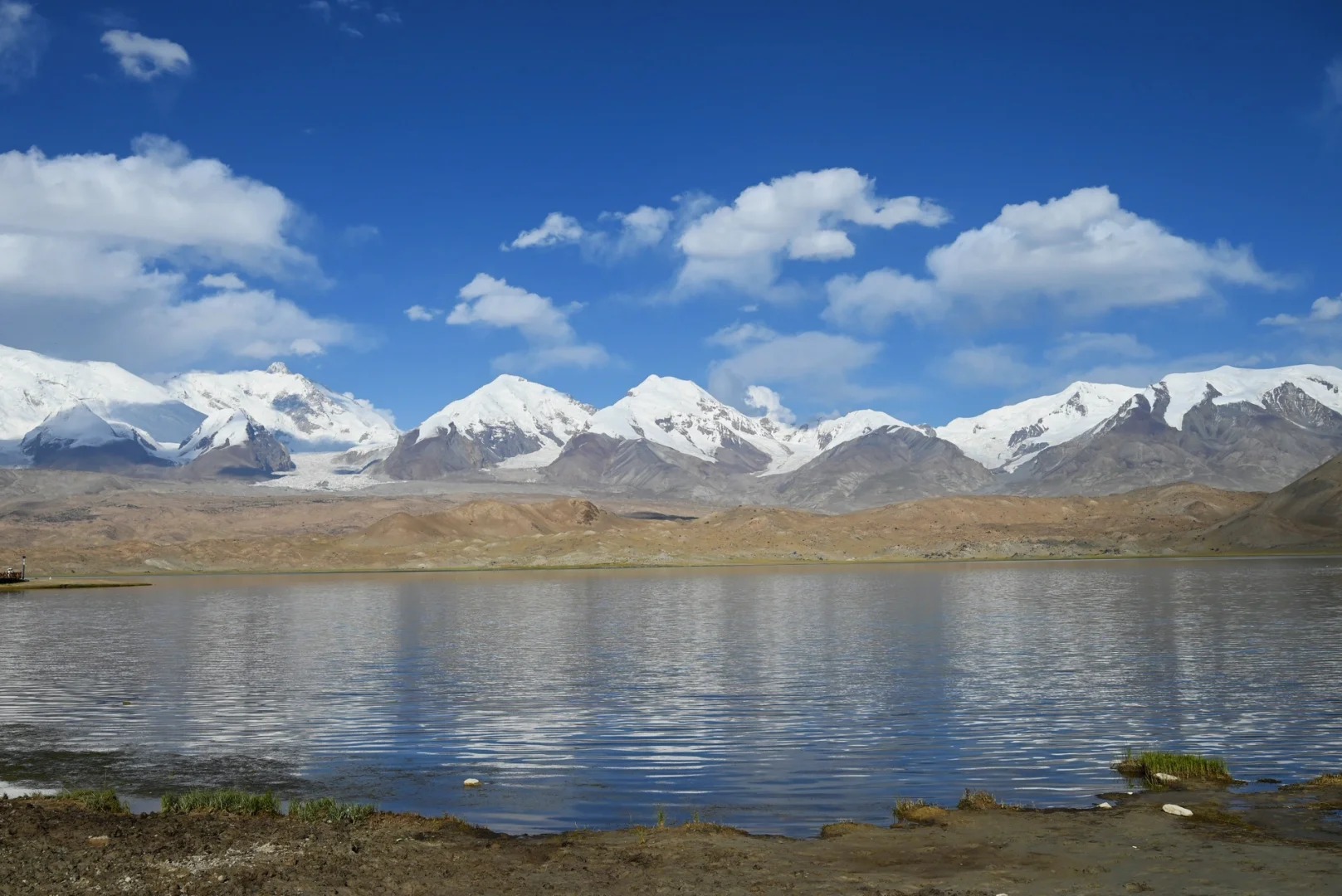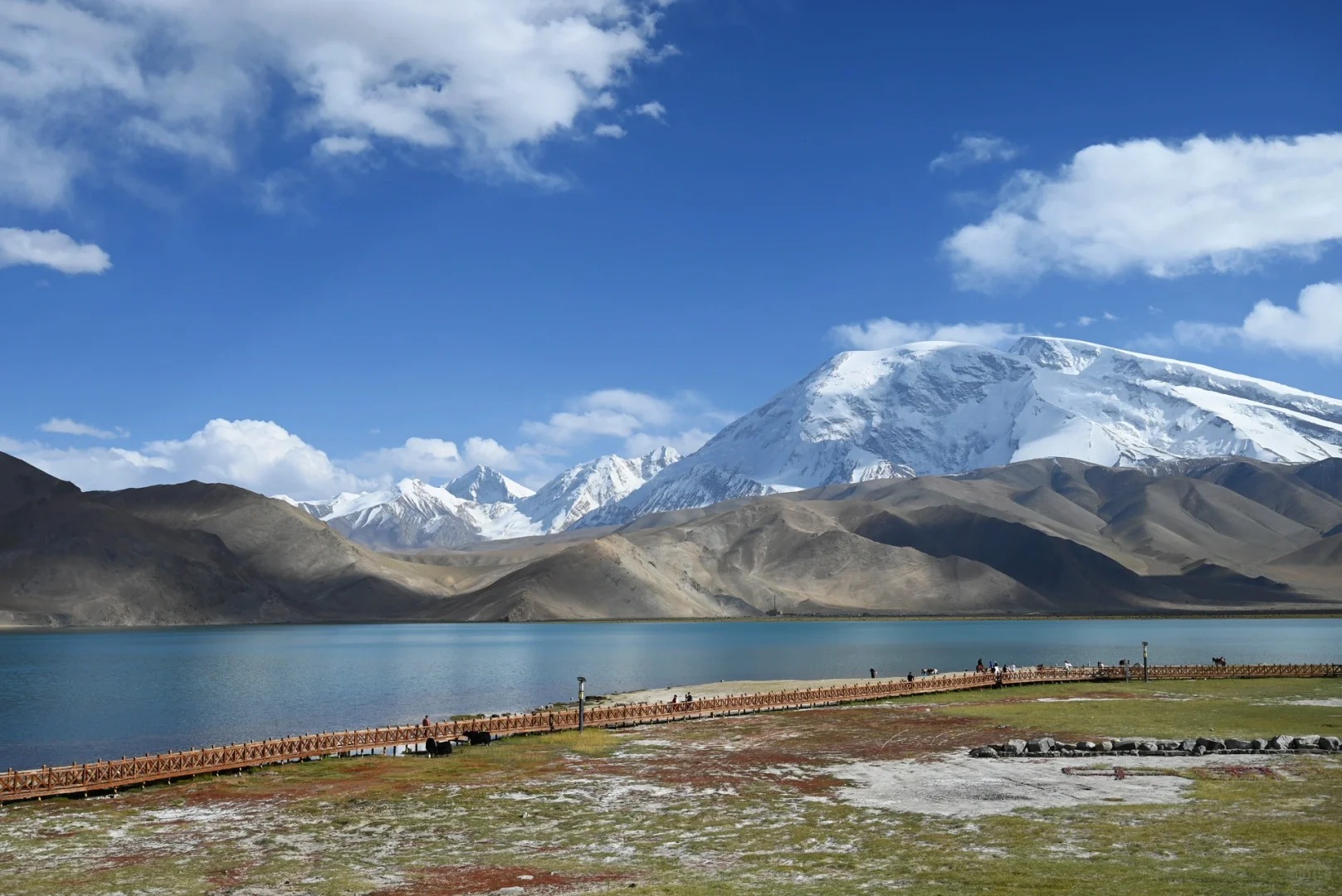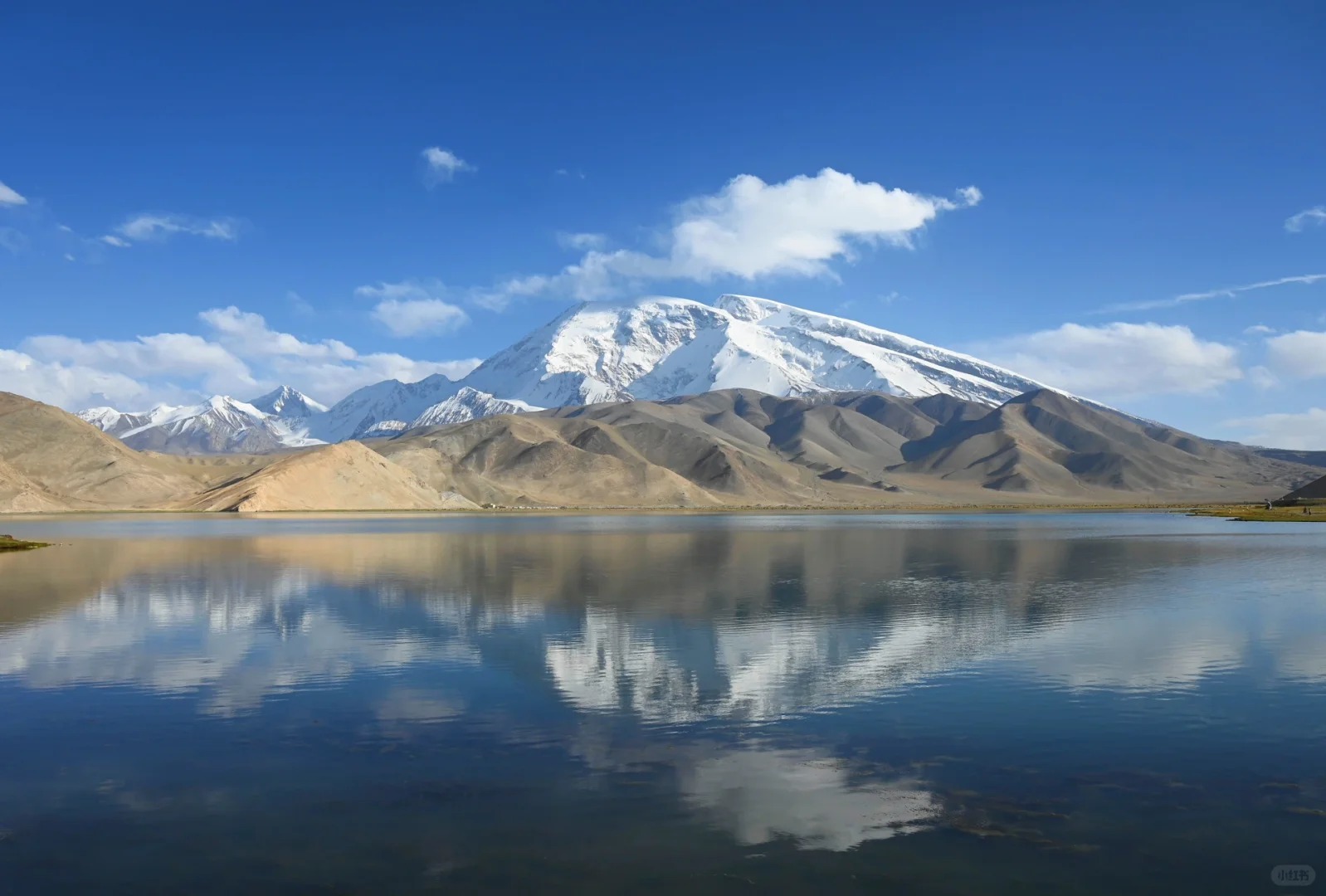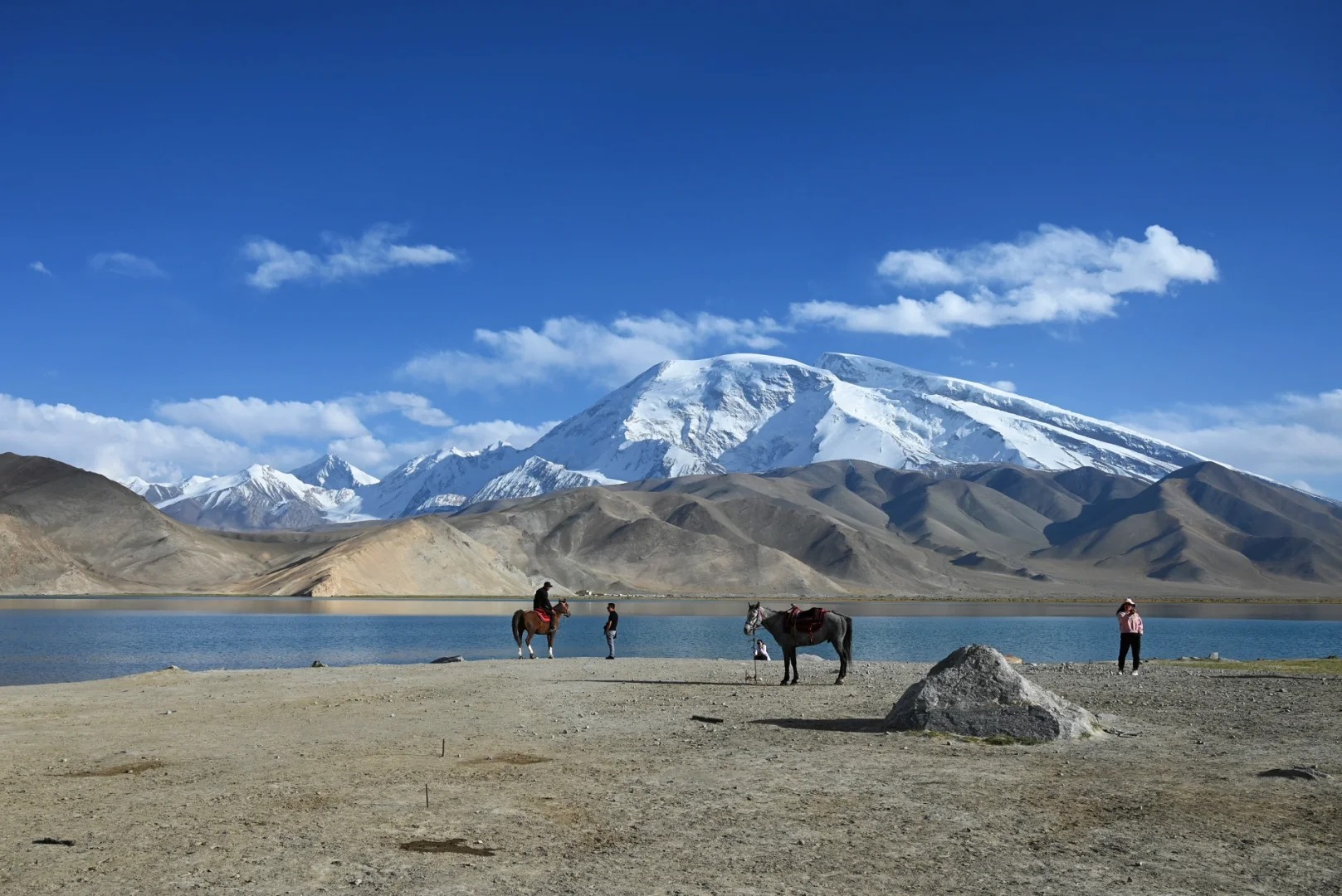Visiting Information
| Information | Details |
|---|---|
| Chinese Name | 卡拉库勒湖 (Kǎlākùkè Hú) |
| Location and Address | Kizilsu Kirghiz Autonomous Prefecture, Xinjiang Uygur Autonomous Region, China |
| Opening Time/Hours | Open 24 hours (natural scenic area) |
| Entrance Fee | Free |
| How to Get There | By Car: Drive along the Karakoram Highway from Kashgar (about 3-4 hours) By Bus: Take a bus from Kashgar to Tashkurgan and get off at Karakul Lake By Tour: Join an organized tour from Kashgar |
| Best Time for Visit | June to September (Summer to early Autumn) |
| Contact Info | Not applicable (natural scenic area) |
Overview
Karakul Lake, also known as the “Black Lake,” is a stunning high-altitude lake located in the Pamir Mountains of Xinjiang, China. Situated at an elevation of approximately 3,600 meters (11,800 feet) above sea level, it is one of the highest lakes in the Pamir plateau. The lake is renowned for its breathtaking scenery, with the snow-capped peaks of Muztagh Ata and Kongur Tagh reflected in its crystal-clear waters, creating a mesmerizing mirror-like effect.
Historical Background
Karakul Lake was formed millions of years ago by glacial movement and tectonic activity in the Pamir Mountains. The lake’s name, which means “black lake” in several Turkic languages, is believed to derive from its dark appearance when viewed from a distance. For centuries, the lake and its surrounding area have been home to Kyrgyz nomads, who have maintained their traditional lifestyle in this harsh but beautiful environment. The lake gained more attention in modern times with the construction of the Karakoram Highway, which passes by its shores, making it more accessible to travelers and tourists.

Natural Features
- Lake Characteristics: Karakul Lake covers an area of approximately 10 square kilometers (3.9 square miles). It is a saline lake with no outflow, fed primarily by glacial melt and precipitation. The lake’s depth can reach up to 242 meters (794 feet) in some areas, making it one of the deeper alpine lakes in the region.
- Surrounding Mountains: The lake is flanked by two impressive peaks of the Pamir Mountains. To the north stands Muztagh Ata (7,509 meters or 24,636 feet), often called the “Father of Ice Mountains,” while to the south rises Kongur Tagh (7,719 meters or 25,325 feet), the highest peak of the Pamirs. These snow-capped giants create a stunning backdrop for the lake and contribute to its allure as a natural wonder.
- Ecosystem: Despite its high altitude and harsh climate, Karakul Lake supports a unique ecosystem. The lake and its surroundings are home to various species of birds, including bar-headed geese and Tibetan sandgrouse. The grasslands around the lake provide grazing grounds for yaks, sheep, and camels tended by local Kyrgyz herders.
- Glacial Landscape: The area around Karakul Lake showcases classic glacial landforms, including U-shaped valleys, moraines, and erratic boulders. These features offer insights into the geological history of the region and the powerful forces that shaped this high-altitude landscape.
Cultural Importance
Karakul Lake holds significant cultural importance for the Kyrgyz nomads who have inhabited the area for generations. The lake and its surrounding grasslands have long been essential to their pastoral lifestyle, providing water for their livestock and a backdrop for their traditional yurt settlements. The area around the lake serves as a living example of the nomadic culture that has persisted in Central Asia for centuries. Additionally, the lake’s location along the ancient Silk Road routes has made it a witness to centuries of trade and cultural exchange between East and West.
Surrounding Attractions
- Muztagh Ata: This iconic peak, visible from Karakul Lake, is a popular destination for mountaineers and trekkers. The mountain’s relatively gentle slopes make it one of the more accessible 7,000-meter peaks for climbing expeditions. Even for non-climbers, the views of Muztagh Ata from the lake shore are awe-inspiring.
- Karakoram Highway: Often referred to as the “Eighth Wonder of the World,” this international highway connects China and Pakistan through some of the most challenging terrains on Earth. The stretch near Karakul Lake offers spectacular views and is considered one of the most scenic parts of the entire route.
- Tashkurgan: Located about 80 kilometers south of Karakul Lake, Tashkurgan is an ancient town with a rich history dating back over 2,000 years. It features the ruins of a Stone City fortress and is home to the Tajik ethnic minority. The town provides insights into the cultural diversity of the region.
- White Sand Lake: About 30 kilometers north of Karakul Lake, White Sand Lake (Bulunkou Lake) offers another stunning alpine lake experience. Its shores are lined with sand dunes, creating a unique landscape where desert meets high-altitude water.

Photography Opportunities
- Reflections: The calm surface of Karakul Lake often acts as a perfect mirror, reflecting the surrounding mountains and sky. This phenomenon creates stunning opportunities for landscape photography, especially during sunrise and sunset when the light conditions are most dramatic.
- Mountain Vistas: The towering peaks of Muztagh Ata and Kongur Tagh provide a majestic backdrop for wide-angle landscape shots. Their snow-capped summits contrasting with the blue lake and sky offer classic mountain photography opportunities.
- Nomadic Life: The Kyrgyz yurts and nomads around the lake offer unique chances for cultural and portrait photography. Capturing the traditional lifestyle against the backdrop of this high-altitude landscape can result in compelling images.
- Night Sky: The high altitude and minimal light pollution make Karakul Lake an excellent location for astrophotography. On clear nights, the Milky Way can be visible, creating opportunities for stunning starscape images over the lake and mountains.
Modern Importance
- Tourism: Karakul Lake has become an important tourist destination in Xinjiang, attracting both domestic and international visitors. Its stunning beauty and accessibility via the Karakoram Highway have made it a key stop on many Silk Road and Pamir Mountain tours, contributing to the local and regional tourism economy.
- Scientific Research: The lake and its surrounding environment provide valuable opportunities for scientific study in various fields, including geology, glaciology, and high-altitude ecology. Research conducted in this area contributes to our understanding of climate change impacts on high-altitude ecosystems.
- Cultural Preservation: The area around Karakul Lake serves as a living museum of Kyrgyz nomadic culture. Efforts to maintain traditional lifestyles while adapting to modern challenges highlight the importance of cultural preservation in rapidly changing environments.
- Environmental Conservation: As a fragile high-altitude ecosystem, Karakul Lake has become a focus of environmental conservation efforts. Balancing tourism development with ecological protection is crucial for maintaining the area’s natural beauty and biodiversity for future generations.

FAQ
- What is Karakul Lake famous for?
Karakul Lake is famous for its stunning high-altitude scenery, with crystal-clear waters reflecting the surrounding snow-capped peaks of Muztagh Ata and Kongur Tagh. It’s also known for its unique ecosystem and the traditional Kyrgyz nomadic culture in the area. - What’s inside Karakul Lake?
Karakul Lake is a natural alpine lake. Inside, you’ll find clear, saline water that supports a unique high-altitude ecosystem. The lake is surrounded by grasslands where you can see grazing yaks and sheep, as well as traditional Kyrgyz yurts. - Is Karakul Lake free?
Yes, Karakul Lake is free to visit. There is no entrance fee as it is a natural scenic area. - Is Karakul Lake worth visiting?
Absolutely! Karakul Lake is considered one of the most beautiful spots in Xinjiang. Its breathtaking scenery, unique high-altitude environment, and glimpse into traditional nomadic culture make it a must-visit for many travelers to the region. - What to do in Karakul Lake?
At Karakul Lake, you can enjoy the stunning views, take photographs, go for walks around the lakeshore, interact with local Kyrgyz people, stay in a yurt for a unique cultural experience, and use it as a base for further exploration of the surrounding mountains. - How do I get to Karakul Lake in the local city?
To get to Karakul Lake from Kashgar (the nearest major city):
1. By Car: Drive along the Karakoram Highway for about 3-4 hours.
2. By Bus: Take a bus from Kashgar to Tashkurgan and ask to be dropped off at Karakul Lake.
3. By Tour: Join an organized tour from Kashgar, which often includes transportation and can be the most convenient option for foreign visitors. - How to visit Karakul Lake?
To visit Karakul Lake:
1. Plan your trip during the summer months (June to September) for the best weather.
2. Arrange transportation from Kashgar (by car, bus, or tour).
3. Bring warm clothes as it can be cold even in summer due to the high altitude.
4. Consider staying overnight in a yurt for a full experience.
5. Respect the local environment and culture during your visit.
6. Be prepared for high altitude and take necessary precautions.
7. Bring your own food and water as facilities are limited.
8. Allow enough time to enjoy the scenery and take photographs.


